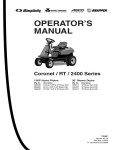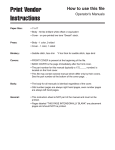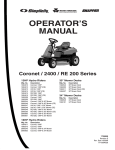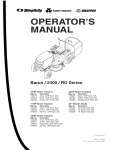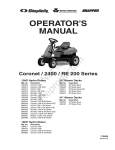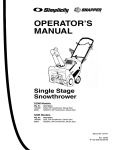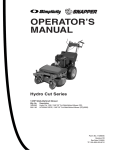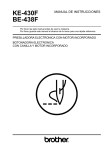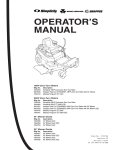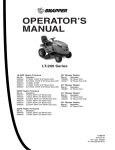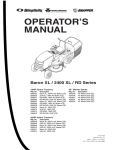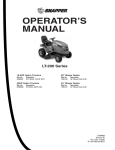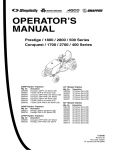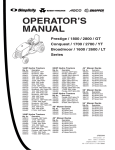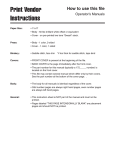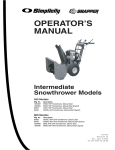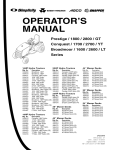Download Snapper 355ZB2444 Lawn Mower User Manual
Transcript
OPERATOR’S MANUAL Coronet / 400 / 2400 Series 13HP Hydro Riders 30” Mower Decks Mfg. No. 1694462 1694464 1694510 1694512 1694514 1694536 Mfg. No. 1692543 1694053 1694511 1694513 1694515 1694537 Description Coronet, 13HP Hydro 2413H, 13HP Hydro Coronet, 13HP Hydro (CE) RT1330, 13HP Hydro RT1330, 13HP Hydro (CE) 2413H, 13HP Hydro (CE) Description 30” Mower Deck 30” Mower Deck 30” Mower Deck (CE) 30” Mower Deck 30” Mower Deck (CE) 30” Mower Deck 16HP Hydro Riders 34” Mower Decks Mfg. No. 1694463 Mfg. No. 1692545 Description Coronet, 16HP Hydro Description 34” Mower Deck 1726339-01 Revision No. 01 Rev. Date 11/2003 TP 100-3909-01-CO-SMAN Table of Contents Identification Numbers........................................2 Safety Rules & Information.................................3 Safety Decals .......................................................6 Features & Controls ............................................8 Troubleshooting, Adjustments & Service .......21 Troubleshooting the Rider.....................................21 Troubleshooting the Mower ..................................22 Seat Adjustment....................................................23 Steering Gear Adjustment.....................................23 Steering Wheel Adjustment ..................................23 Brake Adjustment..................................................24 Blade Brake Adjustment .......................................24 Mower Adjustments ..............................................25 Battery Charging ...................................................27 Rider Drive Belt Replacement...............................28 Mower Belt Replacement ......................................28 Control Functions ....................................................8 Safety Interlock System ........................................10 Operating the Rider ...........................................10 General .................................................................10 Adding Fuel ...........................................................10 Checks Before Starting .........................................10 Brake Pedal Operation..........................................11 Starting The Engine ..............................................11 Selecting Ground & Engine Speed .......................12 Stopping the Rider ................................................12 Operating the Mower ............................................13 Pushing the Rider by Hand ..................................13 Mower Removal and Installation ...........................14 Storage .................................................................15 Specifications ....................................................29 Parts & Accessories..........................................30 Lawn Care & Mowing Information .............LC—1 International Symbols ................................LC—8 Technical Manuals ......................................LC—8 Regular Maintenance ........................................16 Maintenance Schedule .........................................16 Checking Tire Pressures.......................................16 Raising the Seat Deck ..........................................17 Adding Fuel ...........................................................17 Fuel Filter ..............................................................17 Oil & Filter Change................................................17 Check / Change Air FIlter......................................17 Replace Spark Plug ..............................................17 Lubrication ............................................................18 Battery Maintenance .............................................19 Cleaning the Battery and Cables ..................19 Lubricate Rear Axle Shafts ...................................19 Servicing the Mower Blades .................................20 NOTE: In this manual, “left” and “right” are referred to as seen from the operating position. 1 Identification Numbers Identification Numbers SA M North American Models PL E 169XXXX SA Mfg. No.: Mower ID Tag Tractor ID Tag 2002 dB(A) CE Models PRODUCT M Serial No.: XXXXX kW: XXX Engine RPM XXXX LpA: XXX dB(A) Vibration @ Wheel: XXX m/s² Vibration @ Seat: XXX m/s² REFERENCE DATA Model Description Name/Number PL Simplicity Mfg. Inc. Port Washington, WI USA 53074-0997 E When contacting your authorized dealer for replacement parts, service, or information you MUST have these numbers. Record your model name/number, manufacturer’s identification numbers, and engine serial numbers in the space provided for easy access. These numbers can be found in the locations shown. Unit MFG Number Unit SERIAL Number Mower Deck MFG Number Mower Deck SERIAL Number Dealer Name Date Purchased ENGINE REFERENCE DATA NOTE: For location of engine identification numbers, refer to the engine owner’s manual. Engine Make Engine Model Engine Type/Spec Engine Code/Serial Number CE Models: Place the extra copy of the identification tag in the manual CE IDENTIFICATION TAG MARKINGS A. B. C. D. E. F. G. H. I. J. K. L. M. A B Manufacturer’s Identification Number Manufacturer’s Serial Number Power Rating in Kilowatts Maximum Engine Speed in Rotations per Minute Manufacturer’s Address Year of Manufacture CE Compliance Logo Mass of Unit in Kilograms Sound Power in Decibels *** Sound Pressure at Operator’s Position in Decibels ** Vibration at the Steering Wheel * Vibration at the Seat * Combination Number C F Mfg. No.: J K I 169XXXX Serial No.: XXXXX kW: XX Engine RPM XXXX LpA: XXX dB(A) Vibration @ Wheel: XXX m/s² Vibration @ Seat: XXX m/s² D G XXXX dB(A) H Simplicity Mfg. Inc. Port Washington, WI USA 53074-0997 L XXXXXXX M E This unit complies with European Harmonized Lawn Mower Standard EN 836, European Machinery Directive 98/37/CE, and European EMC Directive 89/336/CE CE Models: Place copy of Identification Tag here. * Tested according to EN 836:1997/A2:2001, EN 1032: 1996, EN 1033:1995 ** Tested according to EN836:1997/A2:2001 *** Tested according to 2000/14/CE 2 Safety Rules & Information Read these safety rules and follow them closely. Failure to obey these rules could result in loss of control of unit, severe personal injury or death to you, or bystanders, or damage to property or equipment. This mowing deck is capable of amputating hands and feet and throwing objects. The triangle in text signifies important cautions or warnings which must be followed. 16. Use extra care when loading or unloading the unit into a trailer or truck. 17. Always wear eye protection when operating this unit. 18. Data indicates that operators, age 60 years and above, are involved in a large percentage of riding mower-related injuries. These operators should evaluate their ability to operate the riding mower safely enough to protect themselves and others from injury. 19. Follow the manufacturer’s recommendations for wheel weights or counterweights. 20. Keep in mind the operator is responsible for accidents occurring to other people or property. 21. All drivers should seek and obtain professional and practical instruction. 22. Always wear substantial footwear and trousers. Never operate when barefoot or wearing sandals. 23. Before using, always visually check that the blades and blade hardware are present, intact, and secure. Replace worn or damaged parts. 24. Disengage attachments before: refueling, removing an attachment, making adjustments (unless the adjustment can be made from the operator’s position). 25. When the machine is parked, stored, or left unattended, lower the cutting means unless a positive mechanical lock is used. 26. Before leaving the operator’s position for any reason, engage the parking brake, disengage the PTO, stop the engine, and remove the key. 27. To reduce fire hazard, keep the unit free of grass, leaves, & excess oil. Do not stop or park over dry leaves, grass, or combustible materials. 28. It is a violation of California Public Resource Code Section 4442 to use or operate the engine on or near any forest-covered, brush-covered, or grass-covered land unless the exhaust system is equipped with a spark arrester meeting any applicable local or state laws. Other states or federal areas may have similar laws. GENERAL OPERATION 1. Read, understand, and follow all instructions in the manual and on the unit before starting. 2. Do not put hands or feet near rotating parts or under the machine. Keep clear of the discharge opening at all times. 3. Only allow responsible adults, who are familiar with the instructions, to operate the unit (local regulations can restrict operator age). 4. Clear the area of objects such as rocks, toys, wire, etc., which could be picked up and thrown by the blade(s). 5. Be sure the area is clear of other people before mowing. Stop the unit if anyone enters the area. 6. Never carry passengers. 7. Do not mow in reverse unless absolutely necessary. Always look down and behind before and while travelling in reverse. 8. Never direct discharge material toward anyone. Avoid discharging material against a wall or obstruction. Material may ricochet back toward the operator. Stop the blade(s) when crossing gravel surfaces. 9. Do not operate the machine without the entire grass catcher, discharge guard (deflector), or other safety devices in place. 10. Slow down before turning. 11. Never leave a running unit unattended. Always disengage the PTO, set parking brake, stop engine, and remove keys before dismounting. 12. Disengage blades (PTO) when not mowing. Shut off engine and wait for all parts to come to a complete stop before cleaning the machine, removing the grass catcher, or unclogging the discharge guard. 13. Operate the machine only in daylight or good artificial light. 14. Do not operate the unit while under the influence of alcohol or drugs. 15 Watch for traffic when operating near or crossing roadways. TRANSPORTING AND STORAGE 4. Always follow the engine manual instructions for storage preparations before storing the tractor for both short and long term periods. 5. Always follow the engine manual instructions for proper start-up procedures when returning the unit to service. 6. Never store the unit or fuel container inside where there is an open flame or pilot light, such as in a water heater. Allow unit to cool before storing. 1. When transporting the unit on an open trailer, make sure it is facing forward, in the direction of travel. If the unit is facing backwards, wind lift could damage the unit. 2. Always observe safe refueling and fuel handling practices when refueling the tractor after transportation or storage. 3. Never store the unit (with fuel) in an enclosed poorly ventilated structure. Fuel vapors can travel to an ignition source (such as a furnace, water heater, etc.) and cause an explosion. Fuel vapor is also toxic to humans and animals. TP 600-2459-05-UV-SMA 3 Safety Rules and Information SLOPE OPERATION WARNING Slopes are a major factor related to loss-of-control and tipover accidents, which can result in severe injury or death. Operation on all slopes requires extra caution. If you cannot back up the slope or if you feel uneasy on it, do not operate on it. Control of a ride-on machine sliding on a slope will not be regained by the application of the brake. The main reasons for loss of control are: insufficient tire grip on the ground, speed too fast, inadequate braking, the type of machine is unsuitable for its task, lack of awareness of the ground conditions, incorrect hitching and load distribution. 1. Mow up and down slopes, not across. 2. Watch for holes, ruts, or bumps. Uneven terrain could overturn the unit. Tall grass can hide obstacles. 3. Choose a slow speed so that you will not have to stop or change speeds while on the slope. 4. Do not mow on wet grass. Tires may lose traction. 5. Always keep unit in gear especially when traveling down slopes. Do not shift to neutral and coast downhill. 6. Avoid starting, stopping, or turning on a slope. If tires lose traction, disengage the blade(s) and proceed slowly straight down the slope. 7. Keep all movement on slopes slow and gradual. Do not make sudden changes in speed or direction, which could cause the machine to rollover. 8. Use extra care while operating machines with grass catchers or other attachment; they can affect the stability of the unit. 9. Do not try to stabilize the machine by putting your foot on the ground. 10. Do not mow near drop-offs, ditches, or embankments. The mower could suddenly turn over if a wheel is over the edge of a cliff or ditch, or if an edge caves in. 11. Do not use grass catchers on steep slopes. 12. Do not mow slopes you cannot back up. 13. See your authorized dealer for recommendations of wheel weights or counterweights to improve stability. 14. Remove obstacles such as rocks, tree limbs, etc. 15. Use slow speed. Tires may lose traction on slopes even through the brakes are functioning properly. 16. Do not turn on slopes unless necessary, and then, turn slowly and gradually downhill, if possible. Never operate on slopes greater than 17.6 percent (10°) which is a rise of 3-1/2 feet (106 cm) vertically in 20 feet (607 cm) horizontally. When operating on slopes use additional wheel weights or counterweights. See your dealer to determine which weights are available and appropriate for your unit. Select slow ground speed before driving onto slope. In addition to front and rear weights, use extra caution when operating on slopes with rear-mounted grass catcher. Mow UP and DOWN the slope, never across the face, use caution when changing directions and DO NOT START OR STOP ON SLOPE. CHILDREN Tragic accidents can occur if the operator is not alert to the presence of children. Children are often attracted to the unit and the mowing activity. Never assume that children will remain where you last saw them. 1. Keep children out of the mowing area and under the watchful care of another responsible adult. 2. Be alert and turn unit off if children enter the area. 3. Before and during reverse operation, look behind and down for small children. 4. Never carry children, even with the blade(s) off. They may fall off and be seriously injured or interfere with safe unit operation. Children who have been given rides in the past may suddenly appear in the mowing area for another ride and be run over or backed over by the machine. 5. Never allow children to operate the unit. 6. Use extra care when approaching blind corners, shrubs, trees, or other objects that may obscure vision. EMISSIONS 1. Engine exhaust from this product contains chemicals known, in certain quantities, to cause cancer, birth defects, or other reproductive harm. 2. Look for the relevant Emissions Durability Period and Air Index information on the engine emissions label. TOWED EQUIPMENT 1. Tow only with a machine that has a hitch designed for towing. Do not attach towed equipment except at the hitch point. 2. Follow the manufacturer’s recommendations for weight limit for towed equipment and towing on slopes. 3. Never allow children or others in or on towed equipment. 4. On slopes, the weight of the towed equipment may cause loss of traction and loss of control. 5. Travel slowly and allow extra distance to stop. 6. Do not shift to neutral and coast down hill. IGNITION SYSTEM 1. This spark ignition system complies with Canadian ICES-002. 4 Safety Rules and Information SERVICE AND MAINTENANCE Safe Handling of Gasoline 1. Extinguish all cigarettes, cigars, pipes, and other sources of ignition. 2. Use only approved gasoline containers. 3. Never remove the gas cap or add fuel with the engine running. Allow the engine to cool before refueling. 4. Never fuel the machine indoors. 5. Never store the machine or fuel container where there is an open flame, spark, or pilot light such as near a water heater or other appliance. 6. Never fill containers inside a vehicle or on a truck bed with a plastic bed liner. Always place containers on the ground away from your vehicle before filling. 7. Remove gas-powered equipment from the truck or trailer and refuel it on the ground. If this is not possible, then refuel such equipment on a trailer with a portable container, rather than from a gasoline dispenser nozzle. 8. Keep nozzle in contact with the rim of the fuel tank or container opening at all times until fueling is complete. Do not use a nozzle lock-open device. 9. If fuel is spilled on clothing, change clothing immediately. 10. Never over fill the fuel tank. Replace gas cap and tighten securely. 11. Use extra care in handling gasoline and other fuels. They are flammable and vapors are explosive. 12. If fuel is spilled, do not attempt to start the engine but move the machine away from the area of spillage and avoid creating any source of ignition until fuel vapors have dissipated. 13. Replace all fuel tank caps and fuel container caps securely. 12. Grass catcher components are subject to wear, damage, and deterioration, which could expose moving parts or allow objects to be thrown. Frequently check components and replace with manufacturer’s recommended parts, when necessary. 13. Mower blades are sharp and can cut. Wrap the blade(s) or wear gloves, and use extra caution when servicing them. 14. Check brake operation frequently. Adjust and service as required. 15. Use only factory authorized replacement parts when making repairs. 16. Always comply with factory specifications on all settings and adjustments. 17. Only authorized service locations should be utilized for major service and repair requirements. 18. Never attempt to make major repairs on this unit unless you have been properly trained. Improper service procedures can result in hazardous operation, equipment damage and voiding of manufacturer’s warranty. 19. On multiple blade mowers, take care as rotating one blade can cause other blades to rotate. 20. Do not change engine governor settings or overspeed the engine. Operating the engine at excessive speed can increase the hazard of personal injury. 21. Disengage drive attachments, stop the engine, remove the key, and disconnect the spark plug wire(s) before: clearing attachment blockages and chutes, performing service work, striking an object, or if the unit vibrates abnormally. After striking an object, inspect the machine for damage and make repairs before restarting and operating the equipment. 22. Never place hands near the moving parts, such as a hydro pump cooling fan, when the tractor is running. (Hydro pump cooling fans are typically located on top of the transaxle). Service & Maintenance 1. Maintain or replace safety and instruction labels as necessary. 2. Never run the unit in an enclosed area where carbon monoxide fumes may collect. 3. Keep nuts and bolts, especially blade attachment bolts, tight and keep equipment in good condition. 4. Never tamper with safety devices. Check their proper operation regularly and make necessary repairs if they are not functioning properly. 5. Keep unit free of grass, leaves, or other debris buildup. Clean up oil or fuel spillage. 6. Stop and inspect the equipment if you strike an object. Repair, if necessary, before restarting. 7. Never make adjustments or repairs with the engine running unless specified otherwise in the engine manufacturer’s manual. 8. Do not remove the fuel filter when the engine is hot as spilled gasoline may ignite. Do not spread fuel line clamps further than necessary. Ensure clamps grip hoses firmly over the filter after installation. 9. Do not use gasoline containing METHANOL, gasohol containing more than 10% ETHANOL, gasoline additives, or white gas because engine/fuel system damage could result. 10. If the fuel tank must be drained, it should be drained outdoors. 11. Replace faulty silencers/mufflers. 5 Safety Decals SAFETY DECALS All DANGER, WARNING, CAUTION and instructional messages on your rider and mower should be carefully read and obeyed. Personal bodily injury can result when these instructions are not followed. The information is for your safety and it is important! The safety decals below are on your rider and mower. This unit has been designed and manufactured to provide you with the safety and reliability you would expect from an industry leader in outdoor power equipment manufacturing. Although reading this manual and the safety instructions it contains will provide you with the necessary basic knowledge to operate this equipment safely and effectively, we have placed several safety labels on the unit to remind you of this important information while you are operating your unit. If any of these decals are lost or damaged, replace them at once. See your local dealer for replacements. NORTH AMERICAN MODELS CE MODELS WARNING AVOID SERIOUS INJURY OR DEATH • READ OPERATOR'S MANUAL(S). • KNOW LOCATION AND FUNCTION OF ALL CONTROLS. • KEEP SAFETY DEVICES (GUARDS, SHIELDS, & SWITCHES) IN PLACE AND WORKING. • REMOVE OBJECTS THAT COULD BE THROWN BY THE BLADE. • DO NOT MOW WHEN CHILDREN OR OTHERS ARE AROUND. • NEVER CARRY CHILDREN EVEN WITH BLADES OFF. • LOOK DOWN AND BEHIND BEFORE AND WHILE BACKING. • AVOID SUDDEN TURNS. • IF YOU CANNOT BACK UP A HILL, DO NOT OPERATE ON IT. • GO UP AND DOWN SLOPES, NOT ACROSS. • IF MACHINE STOPS GOING UPHILL, STOP BLADE AND BACK DOWN SLOWLY. • BE SURE BLADE(S) AND ENGINE ARE STOPPED BEFORE PLACING HANDS OR FEET NEAR BLADE(S). • WHEN LEAVING MACHINE, SHUT OFF ENGINE, REMOVE KEY, AND SET PARKING BRAKE. These labels are easily applied and will act as a constant visual reminder to you, and others who may use the equipment, to follow the safety instructions necessary for safe, effective operation. DANGER ROTATING BLADES CUT OFF ARMS AND LEGS STOP MOWER WHEN CHILDREN ARE NEAR. NO RIDERS — THEY FALL OFF. DANGER OPERATING ON SLOPES CAN BE DANGEROUS SEE OPERATOR'S MANUAL. IF YOU CANNOT BACK-UP A HILL, DO NOT DRIVE ON IT. DO NOT TOW RIDER! Damage may result to transmission. 1726347 1726336 Decal - Operating Instructions, CE Models, Part No. 1726336 Decal - Operating Instructions, North American Models, Part No. 1726347 Decal - Danger, SideDischarge Models Part No. 1704276 Decal - Danger, Rotating Blades Part No. 1720389 Decal - Danger, Side Discharge Models Part No. 1704277 ALL MODELS 1726341 Decal - Transmission Release Part No. 1726341 6 Decal - Ignition Switch Positions Part No. 1722806 CE Safety Icons SAFETY ICONS Danger: Machine Rollover. Warning: Read Operator’s Manual. Do not use this machine on slopes greater than 10°. Read and understand the Operator’s Manual before using this machine. Danger: Thrown Objects. Danger: Dismemberment. This machine is capable of throwing objects and debris. Keep bystanders away. This machine can amputate limbs. Keep bystanders and children away when engine is running. Warning: Remove Key Before Servicing. Danger: Dismemberment. This mower deck can amputate limbs. Keep hands and feet away from blades. Remove the key and consult technical literature before performing repairs or maintenance. 7 Features & Controls + - Figure 1. Controls CONTROL FUNCTIONS The information below briefly describes the function of individual controls. Starting, stopping, driving, and mowing require the combined use of several controls applied in specific sequences. To learn what combination and sequence of controls to use for various tasks see the OPERATION section. Throttle Control Throttle/Choke Control (Single Lever Models) (Twin Lever Models) The throttle/choke lever controls engine speed and choke. Move the throttle forward to increase engine speed and back to decrease engine speed. Always operate at FULL throttle. Move the control fully forward (past the detent) to close the choke. Close the choke for cold starting. Open the choke once the engine starts. A warm engine may not require choking. The throttle controls engine speed. Move the throttle forward to increase engine speed and back to decrease engine speed. Always operate at FULL throttle. Choke (Twin Lever Models) Close the choke for cold starting. Open the choke once the engine starts. A warm engine may not require choking. Move the lever forward to close the choke 8 Features & Controls Fuel Tank Mower Height of Cut Adjustment The cutting height adjustment knob controls the mower cutting height. The cutting height is infinitely adjustable between 1” and 3-3/4.” To remove the cap, turn counterclockwise. PTO Switch The PTO (Power Take-Off) switch engages and disengages attachments that use the PTO. To engage the PTO, pull UP on the switch. Push DOWN to disengage. Note that the operator must be seated firmly in the tractor seat for the PTO to function. Seat Adjustment Lever The seat can be adjusted forward and back. Move the lever, position the seat as desired, and release the lever to lock the seat into position. Attachment Lift Control Lever Transmission Release Valve Lever When using the mower deck, lift the deck off the ground while transporting to and from the job site. DO NOT cut with the mower in the raised, transport position. The transmission release valve lever deactivates the transmission so that the tractor can be pushed by hand. See PUSHING THE TRACTOR BY HAND for operational information. Ignition Switch The ignition switch starts and stops the engine, it has three positions: OFF Stops the engine and shuts off the electrical system. RUN Allows the engine to run and powers the electrical system. START Cranks the engine for starting. NOTE: Never leave the ignition switch in the RUN position with the engine stopped–this drains the battery. Brake Pedal Depressing the brake pedal applies the tractor brake. Ground Speed Lever The tractor’s forward ground speed is controlled by the forward ground speed control lever. The tractor’s reverse ground speed is controlled by the reverse ground speed control pedal. Moving the lever forward will increase ground speed. Note that the further forward the lever is moved, the faster the tractor will travel. Parking Brake The parking brake knob is used to lock the parking brake when the tractor is stopped. Fully depressing the brake pedal and pulling up on the knob engages the parking brake. Refer to page 10 for a full explanation of parking brake functions. 9 Operating the Rider GENERAL OPERATING SAFETY SAFETY INTERLOCK SYSTEM Be sure to read all information in the Safety and Operation sections before attempting to operate this unit. Become familiar with all of the controls and how to stop the unit. This unit is equipped with safety interlock switches and other safety devices. These safety systems are present for your safety, do not attempt to bypass safety switches, and never tamper with safety devices. Check their operation regularly. ADDING FUEL Operational SAFETY Checks To add fuel: 1. Remove the fuel cap (A, Figure 4). 2. Fill the tank. Do not overfill. Leave room in the tank for fuel expansion. Refer to your engine manual for specific fuel recommendations. 3. Install and hand tighten the fuel cap. Your unit is equipped with a seat switch safety system. Check the seat switch operation every fall and spring with the following tests. Test 1 — Engine should NOT crank if any of the following conditions exist: • Transmission lever is OUT of Neutral, OR • PTO switch is engaged (ON), OR • Clutch/brake pedal is NOT fully depressed. Test 2 — Engine SHOULD crank if ALL of the following conditions are met: CHECKS BEFORE STARTING • Transmission lever is IN neutral, AND • PTO switch is NOT engaged, AND • Clutch/brake pedal IS fully depressed. • Check that crankcase is filled to full mark on dipstick. See the engine Operator’s Manual for instructions and oil recommendations. Test 3 — Engine should SHUT OFF if any of the following conditions exist: • Make sure all nuts, bolts, screws and pins are in place and tight. • Operator rises off seat with transmission in gear (control lever out of the neutral gate) AND clutch/brake pedal NOT depressed, OR • Operator rises off seat with clutch/brake pedal NOT fully depressed (parking brake OFF), OR • Operator rises off seat with PTO engaged. NOTE: If operator returns to seat before engine stops, the engine will re-start and electric PTO clutch will re-engage. • Adjust the seat position, and make certain you can reach all controls from operator’s position. • Fill the gasoline tank with fresh fuel. Refer to engine manual for fuel recommendations. • Make certain proper wheel or counterweights are installed if required, and use extra caution if you will be operating the unit on sloping ground. NOTE: Once the engine has stopped, PTO switch must be turned off after operator returns to the seat in order to start the engine. Test 4 — Blade Brake Check Mower blades and mower drive belt should come to a complete stop within five seconds after electric PTO switch is turned off. If mower drive belt does not stop within five seconds, see your dealer. Test 5 — Neutral Safety Checks Neutral Gate Check: The unit should NOT move when the ground speed control lever is in the Neutral gate. Return-To-Neutral: On hydrostatic models, the ground speed control lever should return to the neutral gate when the clutch/brake pedal is fully depressed. WARNING If the unit does not pass a safety test, do not operate it. See your authorized dealer. Under no circumstance should you attempt to defeat the purpose of the safety interlock system. 10 Operating the Rider BRAKE PEDAL OPERATION 1. See Figure 2. Depressing the pedal from position A to B disengages the transmission drive and also returns the transmission control lever to neutral (from forward speeds). Fully depressing the pedal to position B applies the rider brake. 2. See Figure 2. Parking brake is applied at pedal position B when parking brake control knob (C) is pulled up with pedal fully depressed. C + - STARTING THE ENGINE 1. Seat yourself on the rider seat in the operating position. Set the parking brake using the brake pedal (D, Figure 3) and parking brake knob (B). Figure 2. Brake Pedal A. Brake Pedal (Disengaged) B. Brake Pedal (Engaged) C. Parking Brake Knob 2. Disengage the PTO clutch. 3. Set the throttle to FULL. 4. Close the choke. NOTE: A warm engine may not require choking. 5. Insert the ignition key and turn it to START. 6. After the engine starts, move the engine throttle control to SLOW. Warm up the engine by running it for at least a minute. 7. Set throttle to FULL. NOTE: In the event of an emergency the engine can be stopped by simply turning the ignition switch to STOP. Use this method only in emergency situations. For normal engine shut down follow the procedure given in STOPPING THE TRACTOR. B A D C + - E Figure 3. Controls A. Mower Lift Lever B. Parking Brake Knob C. Ground Speed Control Lever D. Clutch/Brake Pedal E. Dial-A-CutTM Control WARNING Make certain the area of operation, and especially the direction of travel is clear of objects, people and animals. Always look DOWN AND BEHIND before backing! 11 Operating the Rider SELECTING GROUND & ENGINE SPEED Ground speed is selected by depressing the clutch/brake pedal (D, Figure 4) and moving the control lever (C, Figure 4) to the appropriate speed selection. If the terrain is rough, hilly or sloping, use first or second gear. If the grass is wet or over 3” (76mm) high, use full engine speed (with slow ground speed) so the mower will have enough power to cut the grass. B A D C 1. If you are ready to mow, lower the mower from the transport position using lever (A, Figure 4) and set the mowing height using the Dial-A-CutTM Control (E, Figure 4). 2. Set the engine throttle for full speed. 3. Use the PTO switch to engage the PTO. 4. Release the parking brake by depressing the clutch/brake pedal and pushing knob (B, Figure 4) down. 5. Move the ground speed control lever (C, Figure 4) to the desired direction and speed of travel to set the rider in motion. 6. Adjust engine throttle to the desired speed. Full throttle is recommended for mowing. + - E Figure 4. Controls A. Mower Lift Lever D. Clutch/Brake Pedal B. Parking Brake Knob E. Dial-A-CutTM Control C. Ground Speed Control Lever STOPPING THE RIDER 1. Move the ground speed control lever (C, Figure 4) into the NEUTRAL position to make a gradual stop. To make a more rapid stop, depress the /brake pedal (D, Figure 4). NOTE: The ground speed control lever will return to neutral from forward automatically when the clutch/brake pedal is depressed. 2. Engage the parking brake by fully depressing brake pedal and pulling up on parking brake knob (B, Figure 4). 3. Use the PTO switch (G, Figure 1) to disengage the PTO. 4. Set the engine throttle (M, Figure 1) to 1/2 throttle setting and allow the engine to idle for 20 seconds. Stopping a hot engine too fast may cause engine damage. 5. Turn key (C, Figure 1) to OFF and remove it. WARNING Make certain the area of operation, and especially the direction of travel is clear of objects, people and animals. Always look DOWN AND BEHIND before backing! 12 Operating the Rider WARNING Make certain direction of travel is clear of objects, people and animals. Always look DOWN AND BEHIND before backing! OPERATING THE MOWER 1. When traveling to or from the work site, fully raise the mower using the mower lift lever (A, Figure 4). At the work site, lower mower using the lift lever. 2. Use the Dial-A-CutTM control (E, Figure 4) to adjust the height of the mower. Pull back slightly on mower lift lever (A, Figure 4) to relieve pressure and turn clockwise to raise mower cutting height, or counterclockwise to lower cutting height. 3. Engage the parking brake. Make sure the PTO switch is disengaged. 4. Start the engine (see STARTING THE ENGINE). 5. Fully lower the mower using the attachment lift lever. 6. Set the throttle to FULL. 7. Engage the PTO (Mower Deck). 8. Begin mowing. See Section LC for tips on mowing patterns, lawn care, and troubleshooting information. 9. When finished, shut off the PTO and raise the mower using the attachment lift control lever. 10. Stop the engine (see STOPPING THE RIDER). NOTE: Cutting height scale is located on the quadrant at base of lift lever. Scale is numbered 1 thru 4, with 4 representing the highest cutting height. *2392 Figure 5. Mower Belt Pattern A. PTO Pulley D. Front Idler Pulley (30”) B. Arbor Pulley (30”) Left Arbor Pulley (34”) Right Arbor Pulley (34”) C. Idler Pulley E. Idler Pulley Arm PUSHING THE RIDER BY HAND 1. Disengage the PTO and turn the engine off. 2. Push the transmission release (A, Figure 6) in and push down to lock into released position. 3. The tractor can now be pushed by hand. B DO NOT TOW TRACTOR Towing the unit will cause transmission damage. • Do not use another vehicle to push or pull this unit. • Do not actuate the transmission release valve lever while the engine is running. A Figure 6. Transmission Release Lever A. Transmission Release Lever B. Fuel Tank Cap 13 Operating the Rider *2396 Figure 7. Mower Removal/Installation (34” mower shown) A. Idler Pulley Arm D. Lift Cable B. Idler Pulley E. Lift Hook C. PTO (Electric Clutch) Pulley F. Rear Trailing Arms WARNING Stop engine and remove key. Do not engage PTO until mower is completely removed or installed and operator is seated. MOWER REMOVAL AND INSTALLATION NOTE: Perform mower installation on a hard, level surface such as a concrete floor. For easier mower removal and installation, rear trailing arms (F, Figure 7) can be removed by removing spring clips and clevis pins. *2390 Figure 8. Mower Hitch A. Lever B. Mower Hitch 1. Park rider and turn off PTO switch and engine, remove the key and apply parking brake. Turn the wheels fully to the left. 2. On left-hand side of 34” mower, push idler pulley arm (A, Figure 7) to relieve belt tension. C. Rider Hitch Brackets 5. Remove mower hitch (B, Figure 8) from rider hitch brackets (C) by pulling spring-loaded lever (A) forward and lifting up on hitch. Place mower hitch on ground. On right-hand side of 30” mower, pull idler pulley arm to relieve belt tension. 6. With wheels turned fully left, remove mower from underneath right-hand side of rider. 3. With belt tension relieved, remove belt from idler pulley (B, Figure 7) and PTO pulley (C). Removing belt relieves tension on the front hitch assembly. 7. To install mower, reverse above steps. Check mower belt pattern (as shown in Figure 5). Make sure that the mower lift cable is installed with hook toward the rear (see Figure 7 inset) and rear trailing arms (F, Figure 7) are positioned above rear torsion bar. Dial-A-CutTM control set to 4. With lift lever down and the lowest setting, remove lift cable (D, Figure 7) from mower hook (see inset illustration, Figure 7). NOTE: Pull back slightly on the lift lever to allow easier turning of the Dial-A-CutTM control. 14 Operating the Rider STORAGE WARNING • Battery life will be increased if it is removed, put in a cool, dry place and fully charged about once a month. If the battery is left in the unit, disconnect the negative cable. Never store the unit (with fuel) in an enclosed, poorly ventilated structure. Fuel vapors can travel to an ignition source (such as a furnace, water heater, etc.) and cause an explosion. Before starting the unit after it has been stored: • Check all fluid levels. Check all maintenance items. Fuel vapor is also toxic to humans and animals. • Perform all recommended checks and procedures found in the engine owner’s manual. Before you store your unit for the off-season, read the Maintenance and Storage instructions in the Safety Rules section, then perform the following steps: • Allow the engine to warm up for several minutes before use. • Disengage the PTO, set the parking brake, & remove the key. • Perform engine maintenance and storage measures listed in the engine owner’s manual. This includes draining the fuel system, or adding stabilizer to the fuel (do not store a fueled unit in an enclosed structure - see warning). 15 Regular Maintenance MAINTENANCE SCHEDULE & PROCEDURES The following schedule should be followed for normal care of your rider and mower. SAFETY ITEMS Before Each Use Every 5 Hours Every 25 Hours Every 100 Hours Every 250 Hours Spring & Fall Check Safety Interlock System • Check Tractor Brakes Check Mower Blade Stopping Time • • TRACTOR MAINTENANCE ITEMS • Before Each Use Check Tractor/Mower for loose hardware Every 5 Hours Every 25 Hours Every 100 Hours Every 250 Hours Spring & Fall • Lubricate Rear Axle Shafts Clean Battery & Cables Yearly • Check Tire Pressure • Clean Deck & Check/Replace Mower Blades** • Lubricate Rider & Mower • *** Transmission Maintenance ***** ENGINE MAINTENANCE ITEMS Check Engine Oil Level Check / Change Engine Air Filter * Before Each Use Every 5 Hours Every 25 Hours Every 100 Hours • Change Engine Oil & Filter * Inspect Spark Plug(s) * Check / Replace Fuel Filter * * Refer to engine owner’s manual. Change original engine oil after initial break-in period. ** More often in hot (over 85° F: 30° C) weather or dusty operating conditions. *** Service after the first 50 hours of operation, then every 250 hours of operation. **** Service after the first 25 hours of operation, then every 250 hours of operation. ***** See you dealer. CHECK TIRE PRESSURES Tire Pressure should be checked periodically, and maintained at the levels shown in the chart. Note that these pressures may differ slightly from the “Max Inflation” stamped on the side-wall of the tires. The pressures shown provide proper traction, improve cut quality, and extend tire life. Tire Pressure Front 10-12 psi (,68 - ,82 bar) Rear 10-12 psi (,68 - ,82 bar) Figure 9. Checking Tire Pressure 16 Every 250 Hours Spring & Fall Regular Maintenance C B D A E F Figure 10. Engine Compartment A. Fuel Tank B. Ignition Switch C. Battery D. Throttle / Choke Cable E. PTO Switch (Electric Clutch) F. Air Filter G. Oil Fill / Dipstick H. Fuel Filter I. Oil Drain G I H RAISING THE SEAT DECK To gain access to the engine compartment, simply tilt the seat deck forward. ADDING FUEL Do not use gasoline containing METHANOL, gasohol containing more than 10% ethanol, gasoline additives, premium gasoline, or white gas because engine/fuel system damage could result. To add fuel: 1. Remove the fuel cap (A, Figure 10). 2. Fill the tank. Do not overfill. Leave room in the tank for fuel expansion. Refer to your engine manual for specific fuel recommendations. 3. Install and hand tighten the fuel cap. WARNING FUEL FILTER Gasoline is highly flammable and must be handled with care. Never fill the tank when the engine is still hot from recent operation. Do not allow open flame, smoking or matches in the area. Avoid over-filling and wipe up any spills. The fuel filter is located in fuel line between fuel tank and carburetor. If filter is dirty or clogged, replace as follows. Place a container below filter to catch spilled gasoline. 1. Using a pliers, open and slide hose clamps from fuel filter. 2. Remove hoses from filter. 3. Install new filter in proper flow direction in fuel line. Secure with hose clamps. See warning at beginning of procedure. Do not remove fuel filter when engine is hot, as spilled gasoline may ignite. DO NOT spread hose clamps further than necessary. Ensure clamps grip hoses firmly over filter after installation. OIL & FILTER CHANGE Refer to engine owners manual. CHECK / CHANGE AIR FILTER Refer to engine owners manual. REPLACE SPARK PLUG Refer to engine owners manual. 17 Regular Maintenance LUBRICATION Lubricate the rider and mower as shown in Figures 11 16. When a grease gun is shown, wipe the fitting clean, apply two or three shots of lithium base automotive grease, and wipe off excess grease. When an oil can is shown, wipe the area clean, apply a few drops of oil (SAE 30), then wipe up drips or spills. *2388B Figure 14. Rider Lubrication Points - Rear Half (Gear Model Shown) Figure 11. Brake Pedal Pivot Point *2390 Figure 12. Front Axle Lubrication Points Figure 15. Rider Lubrication Points - Front Half *2397 Note: On 30” mower, grease fitting is on topside of deck. Figure 13. Mower Deck Lubrication Points Figure 16. Arbor Lubrication Points 18 Regular Maintenance BATTERY MAINTENANCE WARNING B When removing or installing battery cables, disconnect the negative cable FIRST and reconnect it LAST. If not done in this order, the positive terminal can be shorted to the frame by a tool. C Cleaning the Battery and Cables Service Interval: Every 100 Hours 1. Disconnect the cables from the battery, negative cable first (A, Figure 17). A 2. Remove the battery hold-down (C) and battery. Figure 17. Battery A. Negative Battery Terminal & Cable B. Positive Battery Terminal & Cable C. Hold Down Strap 3. Clean the battery compartment with a solution of baking soda and water. 4. Clean the battery terminals and cable ends with a wire brush and battery terminal cleaner until shiny. 5. Reinstall the battery in the battery compartment, and secure with the battery hold down (C). 6. Reattach the battery cables, positive cable first (B). 7. Coat the cable ends and battery terminals with petroleum jelly or non-conducting grease. LUBRICATE REAR AXLE SHAFTS A Service Interval: Yearly C D We recommend removing the rear wheel hubs and lubricating the axle shafts yearly. This prevents the wheel hubs from seizing onto the axle shaft and makes future service easier. B 1. Turn off the ignition, turn off the PTO, engage the parking brake, and block the front tires. 2. Using a jack or chain hoist positioned at the center of the rear frame, carefully jack the unit up until the rear tires are approximately 1" - 2" (2.5-5cm) off the ground. B E F NOTE: For overall unit stability during service, do not jack rear end higher than required for wheel removal. Figure 18. Rear Axle Hardware A. Key B. Washer C. Spacer 3. Support the rear of the unit on jackstands positioned under the rear frame. NOTE: Your axle assembly may differ slightly from the assembly pictured: the quantity of washers is adjusted on a tractor by tractor basis during assembly to allow a small amount of axle end-play. 4. Remove the hardware retaining the wheel assembly to the axle and lubricate the axle shaft using antiseize compound or lithium grease. 5. Reinstall the components in reverse order of disassembly and lower the unit. Be sure the key (A, Figure 18) is in place in the axle keyway. 19 D. Wheel & Hub E. Retaining Ring F. Axle Cap Regular Maintenance SERVICING THE MOWER BLADES WARNING For your personal safety, do not handle the sharp mower blades with bare hands. Careless or improper handling of blades may result in serious injury. 1. Remove mower from the rider. 2. Blades should be sharp and free of nicks and dents. If not, sharpen blades as described in following steps. 3. To remove blade for sharpening, use wooden block to hold blade while removing the blade mounting capscrew (Figure 19). LOOSEN Figure 19. Removing The Blade 4. Use a file to sharpen blade to fine edge. Remove all nicks and dents in blade edge. If blade is severely damaged, it should be replaced. 5. Balance the blade as shown in Figure 20. Center the blade’s hole on a nail lubricated with a drop of oil. A balanced blade will remain level. 6.Reinstall each blade with the tabs pointing up toward deck as shown in Figure 21. Secure with a capscrew (D), cup washer (C) and hex washer (B). Use a wooden block to prevent blade rotation and torque capscrews to 45-55 ft-lbs (61-75 N-m). Figure 20 Balancing The Blade WARNING B For your personal safety, blade mounting capscrews must each be installed with a hex washer and spring washer, then securely tightened. Torque blade mounting capscrew to 45-55 ft-lbs (61-75 N-m.) C D A Torque to TIGHTEN 45-55 ft-lbs Figure 21. Installing The Blade A. Wooden Block C. Cup Washer B. Hex Washer D. Capscrew 20 Troubleshooting Adjustments & Service TROUBLESHOOTING WARNING While normal care and regular maintenance will extend the life of your equipment, prolonged or constant use may eventually require that service be performed to allow it to continue operating properly. To avoid serious injury, perform maintenance on the tractor or mower only when the engine is stopped and the parking brake engaged. The troubleshooting guide below lists the most common problems, their causes and remedies. Always remove the ignition key, disconnect the spark plug wire and fasten it away from the plug before beginning the maintenance, to prevent accidental starting of the engine. See the information on the following pages for instructions on how to perform most of these minor adjustments and service repairs yourself. If you prefer, all of these procedures can be performed for you by your local authorized dealer. TROUBLESHOOTING THE RIDER PROBLEM CAUSE REMEDY Engine will not turnover or start. 1. Ground speed control lever not in neutral-start position. 2. PTO (electric clutch) switch in ON position. 3. Out of fuel. 1. Shift into neutral. 4. Engine flooded. 5. Circuit breaker tripped. 6. Battery terminals require cleaning. 7. Battery discharged or dead. 8. Wiring loose or broken. Engine starts hard or runs poorly. Engine knocks. Excessive oil consumption. Engine exhaust is black. 9. Solenoid or starter motor faulty. 10. Safety interlock switch faulty. 11. Spark plug(s) faulty, fouled or incorrectly gapped. 12. Water in fuel. 13. Old stale gas. 14. Brake pedal not depressed. 1. Fuel mixture too rich. 2. Carburetor adjusted incorrectly. 3. Spark plug(s) faulty, fouled, or incorrectly gapped. 1. Low oil level. 2. Using wrong grade oil. 1. Engine running too hot. 2. Using wrong weight oil. 3. Too much oil in crankcase. 1. Dirty air filter. 2. Choke not fully open. 21 2. Place in OFF position. 3. If engine is hot, allow it to cool, then refill the fuel tank. 4. Open the CHOKE. 5. Wait one minute for automatic reset. Replace if defective (see your dealer). 6. See Normal Care section. 7. Recharge or replace. 8. Visually check wiring & replace broken or frayed wires. Tighten loose connections. 9. Repair or replace. (see your dealer.) 10. Replace if needed (see your dealer.) 11. Clean and gap or replace. See engine manual. 12. Drain fuel & refill with fresh fuel. 13. Drain fuel & replace with fresh fuel. 14. Depress pedal. 1. Open the CHOKE. If problem persists, clean the air filter. (See engine manual.) 2. See engine manual. 3. Clean & gap or replace. See engine manual. 1. Check/add oil as required. 2. See engine manual. 1. Clean engine fins, blower screen and air cleaner. 2. See engine manual. 3. Drain excess oil. 1. Clean air filter. See engine manual. 2. Open CHOKE. If problem persists, check air filter and carburetor adjustments. See engine manual. Troubleshooting, Adjustment & Service Troubleshooting the Rider (Continued) PROBLEM CAUSE REMEDY Engine runs, but rider will not drive. 1. Ground speed control lever in neutral. 2. Transmission release lever in “push” position. 3. Belt is broken. 4. Drive belt slips. 5. Brake is not fully released. 1. Clutch is out of adjustment. 2. Pulleys or belt greasy or oily. 3. Belt stretched or worn. 4. Idler pulley pivot bracket “frozen” in declutched position. 1. Brake is incorrectly adjusted. 2. Internal brake disc on transaxle worn. 1. Steering linkage is loose. 1. Shift in forward or reverse. Rider drive belt slips. Brake will not hold. Rider steers hard or handles poorly. 2. Improper tire inflation. 3. Spindle bearings dry. TROUBLESHOOTING THE MOWER 2. Move into drive position. 3. See Drive Belt Replacement. 4. See problem and cause below. 5. See Brake Adjustment. 1. See your dealer. 2. Clean as required. 3. Replace with correct belt. 4. Remove idler pulley, clean and lubricate. 1. See Brake Adjustment. 2. See your dealer. 1. Check and tighten any loose connections. See Steering Gear Adjustment. 2. Check and correct. 3. Grease spindles. See Lubricating the rider. PROBLEM CAUSE REMEDY Mower will not raise. 1. Lift cable not properly attached or damaged. 1. Mower not leveled properly. 2. Rider tires not inflated equally or properly. 1. Engine speed too slow. 2. Ground speed too fast. 1. Attach or repair. Mower cut is uneven. Mower cut is rough looking. 1. See Mower Adjustment. 2. See Normal Care. 1. Set to full speed. 2. Set ground speed control lever at a slower ground speed. 3. Blades dull and require sharpening. 3. See Servicing the Mower Blades. 4. Mower drive belt slipping. 4. Belt oily or worn. Clean or replace belt as necessary. 5. Check PTO (Electric Clutch) 5. Clutch may need to be adjusted. Adjustment. 6. Blades not properly fastened 6. See Servicing the Mower Blades. to arbors. Engine stalls easily with 1. Engine speed too slow. 1. Set for 3/4 to full throttle. mower engaged. 2. Ground speed too fast. 2. Reduce ground speed. 3. Carburetor not adjusted properly. 3. Adjust carburetor (See engine manual.) 4. Cutting height set too low when 4. Cut tall grass at maximum cutting height mowing tall grass. during first pass. 5. Discharge chute jamming with 5. Cut grass with discharge pointing toward cut grass. previously cut area. Excessive mower vibration. 1. Blade mounting screws are loose. 1. Tighten to 45-55 ft.lbs. (61-75 N.m.). 2. Mower blade(s), arbors, or pulleys 2. Check and replace as necessary. are bent. 3. Mower blade(s) out of balance. 3. Remove, sharpen and balance blade(s). See Servicing the Mower Blade(s). 4. Belt installed incorrectly. 4. See Belt Replacement. Excessive belt breakage. 1. Bent or rough pulleys. 1. Repair or replace. 2. Using incorrect belt. 2. See your dealer. Mower drive belt slips or fails to drive. 1. Idler pulley spring broken or not 1. See your dealer. properly attached. 2. Mower drive belt broken. 2. Replace. 22 Troubleshooting, Adjustment & Service WARNING To avoid serious injury, perform adjustments only with engine stopped, key removed and rider on level ground. A SEAT ADJUSTMENT Use the lever on the front of the seat (A, Figure 22) on to adjust the seat forward or rearward for best rider comfort. Figure 22. Seat Adjustment A. Seat Adjustment Lever *2401 Capscrews STEERING GEAR ADJUSTMENT If there is excessive slack in the steering system, the steering gear can be re-indexed to the steering shaft. 1. See Figure 23. Loosen the two capscrews (A) and push bracket so that gear teeth are closely meshed. 2. Tighten nuts after adjustment. Torque to 35 - 40ft-lbs. Figure 23. Steering Gear Adjustment A. Capscrews A STEERING WHEEL ADJUSTMENT Your unit is equipped with a dual position steering shaft to allow for steering wheel adjustment for rider comfort. 1. Pull down on the rubber boot to expose the two holes in the steering shaft (A, Figure 24). 2. Use a suitable drift to remove the roll pin at the base of the steering wheel. 3. Align the hole in the steering wheel with the appropriate steering shaft hole and install the roll pin. NOTE: Steering wheel is factory installed with the roll pin in the bottom hole. Figure 24. Steering Wheel Height Adjustment A. Steering Shaft 23 Adjustments BRAKE ADJUSTMENT 1-5/8” - 1-3/4” Brake Adjustment 1. Release the parking brake. 2. Brake arm (C, Figure 25) should be touching stop (B). 3. Remove cotter pin (D) and loosen the castle nut (A). Place a 0.015” feeler gauge (E) gap between the brake disc (F) and the brake puck (G). a. To decrease gap, insert feeler gauge in gap and turn nut (A) clockwise until resistance is felt on the feeler gauge. To increase gap, turn nut (A) counter-clockwise and recheck gap. b. Back off nut (counter-clockwise) until the nearest slot is aligned with hole in threads. Replace cotter pin. 3. Set the parking brake. Loosen or tighten adjustment nut (H) to achieve a 1-5/8” -1-3/4” compressed spring length as shown in Figure 24. H A B G C F D E BLADE BRAKE CHECK Figure 25. Brake Adjustment A. Castle Nut E. Feeler Gauge B. Stop F. Brake Disc C. Brake Arm G. Brake Puck D. Cotter Pin H. Adjustment Nut Mower blades and mower drive belt should come to a complete stop within five seconds after electric PTO switch is turned off. 1. With rider in neutral, PTO disengaged and operator in seat, start the rider engine. 2. Look over the left-hand footrest at the mower drive belt. Engage the PTO and wait several seconds. Disengage the PTO and check the amount of time it takes for the mower drive belt to stop. 3. If mower drive belt does not stop within five seconds, see your dealer. 24 Adjustments MOWER ADJUSTMENTS WARNING If the cut is uneven, the mower may need leveling. Unequal or improper tire pressure may also cause an uneven cut. Make sure tire pressure is correct as specified in Checking Tire Pressure. To achieve proper mower levelling, perform Side-To-Side Leveling, Front-To-Back Leveling and Transport Height Adjustment procedures, in order, as follows. Before checking mower, shut off PTO and engine. Allow all moving parts to stop. Remove ignition key, then disconnect the spark plug wire and fasten it away from the spark plug. *2397 Side-To-Side Leveling 1. With the mower installed, place the rider on a smooth, level surface such as a concrete floor. Turn the front wheels straight forward. 2. Check for bent blades and replace if necessary. 3. Loosen nut (C, Figure 26) so trailing arms are loose. Mower must be resting on rollers with no weight on trailing arms. 4. Use the Dial-A-CutTM Control (E, Figure 27) and place mower in mid-cut position by aligning front edge of mower lift lever (A) with number 2 or 3 on quadrant scale. Make sure mower lift lever is in down position. 5. Make sure rear rollers (C, Figure 28) are on the ground. If not, refer to Transport Height Adjustment. Figure 26. Trailing Arms A. Spacers B. Rear Mower Rollers NOTE: If rollers do not rest on the ground and it is necessary to perform transport height adjustment, it is necessary to perform transport height adjustment again after all leveling procedures are completed. C. Nut D. Rear Trailing Arms WARNING 6. Position blade(s) side-to-side and measure distance from outside tip of blade(s) to ground. Measurement should be equal (within 1/8”). Mower blades are sharp. Turn the mower drive belt to rotate blades into position or wear protective gloves to protect against injury. 7. See Figure 28. On left side of mower, make sure eccentric nut is in correct position as shown. Loosen outside nut (A) and rotate eccentric nut (B) so that flat side with hole closest to it is towards the rear. Tighten outside nut (A) while holding eccentric nut (B). B A 8. On right side of mower, loosen outside nut (A). Turn eccentric nut (B) counterclockwise to raise side of mower, or clockwise to lower right hand side of mower. D C NOTE: Do not turn eccentric nut more than 1/4 turn in either direction. When adjusted beyond 1/4 turn, nut will move mower in opposite direction than when starting adjustment. + - 9. When adjustment is correct, hold eccentric nut (B) and tighten nut (A) to 30 ft-lbs. Check measurement on both sides of mower. E Figure 27. Controls A. Mower Lift Lever D. Clutch/Brake Pedal B. Parking Brake Knob E. Dial-A-CutTM Control C. Ground Speed Control Lever 25 Adjustments *2399 Figure 28. Leveling The Mower Side-to-Side A. Nut B. Eccentric Nut C. Rear Rollers Front-To-Back Leveling *2397 1. Make sure mower is level side-to-side and that rear rollers are on the ground. 2. Position blade(s) front-to-back. Measure the distance from the ground to front tip of blade(s), and from ground to rear tip of blade(s). On 30” mower, the front tip should be level to 1/8” (3 mm) higher than rear tip. On 34” mower, the front tips should be 1/4” (6 mm) higher than the rear tips. 3. See Figure 29. Loosen jam nut (E). To lower rear of mower deck, loosen nut (B) which will lengthen leveling rod (D). To raise rear of deck, shorten leveling rod (D). When proper measurement is obtained, tighten nut (A) against bracket, then tighten jam nut (E) against nut (A). Figure 29. Front-To-Back Levelling A. Adjustment Nut D. Levelling Rod B. Rear Nut E. Jam Nut C. Bracket 26 Adjustments Transport Height Adjustment Transport height should be adjusted so that rear mower rollers are 1/8” - 1/4” (3-6 m) above ground when mower lift lever is in transport position. To adjust, perform both mower leveling procedures first, then do the following procedure. See Figure 30. 1. Park rider on a flat level surface. 2. Adjust Dial-A-CutTM control so that front edge of mower lift lever is aligned with 2-3/4” mark (34” mower) or at 3” mark (30” mower) on the quadrant scale. 3. Loosen nut (C) and position spacer (A) against rear trailing arms (D). Position both the left and right side spacers against trailing arms. 4. Tighten nut (C) securely. 5. Place mower lift lever in transport position. Rear mower rollers should be 1/8” - 1/4” off ground. If not, repeat steps 2 - 4. *2397 Figure 30. Transport Height Adjustment A. Spacers C. Nut B. Rear Mower Rollers D. Rear Trailing Arms BATTERY CHARGING WARNING Keep open flames and sparks away from the battery; the gases coming from it are highly explosive. Ventilate the battery well during charging. A dead battery or one too weak to start the engine may be the result of a defect in the charging system or other electrical component. If there is any doubt about the cause of the problem, see your dealer. If you need to replace the battery, follow the steps under Cleaning the Battery & Cables in the Regular Maintenance Section. To charge the battery, follow the instructions provided by the battery charger manufacturer, as well as, all warnings included in the safety rules sections of this book. Charge the battery until fully charged (until the specific gravity of the electrolyte is 1.250 or higher and the electrolyte temperature is at least 60° F). Do not charge at a rate higher than 10 amps. 27 Belt Replacement *2391 To avoid damaging belts, DO NOT PRY BELTS OVER PULLEYS. RIDER DRIVE BELT Replacement of the rider drive belt requires removal of the transmission and carrier frame. Should the drive belt ever fail, contact your dealer for replacement. MOWER BELT - 30” See Figure 31. Figure 31 Belt Pattern - 30” Mower A. Idler Pulley Arm D. Front Idler Pulley B. Idler Pulley E. PTO Pulley C. Center Arbor Pulley (Electric Clutch) 1. Mower does not need to be removed to install a new belt. However, for easier access, mower can be removed following steps in “Mower Removal and Installation. 2. If mower is not removed, place mower in lowest cutting position. Pull idler pulley arm (A) towards you to relieve belt tension. Remove belt from idler pulley (B) and center arbor pulley (C). 3. Remove belt from front idler pulley (D) and PTO pulley (E). 4. Replace old belt with new belt. Make sure V-side of belt runs in all pulley grooves except for idler pulley (B). Check belt pattern as shown. 5. Install mower if it was removed, and install belt on PTO pulley (E). MOWER BELT - 34” See Figure 32. 1. Mower does not need to be removed to install a new belt. However, for easier access, mower can be removed following steps in “Mower Removal and Installation. Figure 32. Mower Belt Replacement - 34” A. Idler Pulley Arm D. Capscrews B. Idler Pulley E. Arbor Cover C. PTO Pulley 2. If mower is not removed, place mower in lowest cutting position. Push idler pulley arm (A, Figure 32) away from you to relieve belt tension. Remove belt from idler pulley (B) and PTO pulley (C). 3. Remove the three capscrews (D, Figure 31) securing the left-hand arbor cover. 4. Remove old belt from arbor pulleys and replace with new belt. Make sure V-side of belt runs in all arbor pulley grooves and flat side of belt runs against idler pulley. See Figure 33 for belt pattern 5. Install mower if it was removed, and install belt to PTO pulley (C, Figure 32). Push idler arm and install belt around idler pulley. Figure 33. Belt Pattern - 34” Mower A. Idler Arm Pulley D. Right Arbor Pulley B. Idler Pulley E. Left Arbor Pulley C. PTO Pulley 28 Specifications NOTE: Specifications are correct at time of printing and are subject to change without notice. ENGINE CHASSIS 13 HP Intek OHV — Briggs & Stratton Front Wheels Horsepower Displacement Electrical Air Cleaner Oil Capacity 13 HP @ 3400 rpm 21 Cu. In. (344 cc) 12 Volt, 3 Amp D.C. Battery 230 CCA Pre-Cleaned Air to Paper Filter 3 Pints (1.42 L) Rear Wheels Fuel Tank Turning Radius 16 HP Command™ — Kohler Horsepower Displacement Electrical Oil Capacity DIMENSIONS 16 HP @ 3400 rpm 27.9 Cu. In. (460 cc) 12 Volt, 15 Amp Alternator Battery: 230 CCA 4 Pints (1.9 L) Overall Length 61 In. (155 cm) Overall Width - w/30 mower 38.5 In. (97.8 cm) - w/34 mower 45.5 In. (115.6 cm) - at rear wheels 33 In. (83.8 cm) Height at - steering wheel 41 In. (104.1 cm) - seat back 35 In. (88.9 cm) - engine cover 28 In. (71.1 cm) Wheel Base 43 In. (109.2 cm) Weight (appx.) - 13 HP w/34”mower Net: 405 lbs. (183 kg) - 16 HP w/34”mower Net: 405 lbs. (183 kg) TRANSMISSION Hydro Models Type Lubrication Ground Speeds Tire Size 13 x 5.00-6 Pneumatic Inflation Pressure 10 -12 psi (,68 - ,82 bar) Tire Size 16 x 6.50-8 Pneumatic Inflation Pressure 10 -12 psi (,68 - ,82 bar) Material: Non-Corrosive Polyethylene Capacity: 2 Gallons (7.5 L) Inside Rear Tire 12 In. (30.2 cm) Hydrostatic Transmission is a Sealed Unit Infinite Forward: 0-5.2 MPH (0-8.4 km/h) Reverse: 0-2.3 MPH (0-3.7 km/h) 29 Parts & Accessories REPLACEMENT PARTS TECHNICAL MANUALS Replacement parts are available from your authorized dealer. Always use genuine Simplicity Service Parts. Additional copies of this manual are available, as well as fully illustrated parts lists. These manuals show all of the product’s components in exploded views (3D illustrations which show the relationship of parts and how they go together) as well as part numbers and quantities used. Important assembly notes and and torque values are also included. MAINTENANCE ITEMS Many convenient and helpful service and maintenance items are available from you authorized dealer. Some of these items include: Engine Oil Touch-Up Paint Grease Gun Kit 8 oz. Grease Tube For applicable manuals currently available for your model, contact our Customer Publications Department at 262-284-8519. Have the information listed in the box below available when phoning in your request. Technical manuals can be downloaded from www.simplicitymfg.com Tire Sealant Degrimer/Degreaser Gas Stabilizer OPTIONAL ACCESSORIES Twin Bag Grass Catcher Dump Cart Hour Meter Kit Gas Can Front Weight Model: Mfg. No.: Your Name: Address: City, State, Zip: Visa/Mastercard No.: Card Expiration Date: 30 Lawn Care & Mowing Information HOW AND WHEN TO WATER, FERTILIZE & AERATE HOW TO WATER YOUR LAWN Most lawns are watered too often, but with too little water. However too much water can allow development of diseases with your lawn. It is best to water the lawn only when necessary, and then to water it slowly, evenly, and deeply—imitating a slow, soaking rain. HOW TO FERTILIZE YOUR LAWN The best method of watering a lawn is to imitate a slow, soaking rain, applying about 1 inch of water. Fertilizing with a slow-release fertilizer provides missing nutrients which help create slow, even growth. Remember that over-fertilizing can cause harm, and that most fertilizing should be applied in the spring so that it will release into the lawn through the summer. WHEN TO WATER YOUR LAWN When the lawn begins to wilt, the grass’s color dulls, or footprints stay compressed for more than a few seconds, the lawn is beginning to dry out, and needs additional moisture. The best time to water is early morning to allow the water to soak deeply into the lawn and reduce the amount that evaporates in the hot afternoon sun. AERATING YOUR LAWN Consider aerating your lawn in spring. Using an aerator to remove cores of soil from the lawn increases the speed of clipping decomposition and encourages deeper root growth by opening up the soil and permitting greater movement of water, fertilizer and air. HOW HIGH TO MOW THE GRASS Cut less than 1/3 Cutting the grass too short causes weak, thin grass plants, which are easily damaged by dry periods and pests. Letting grass grow a bit longer—especially when it is hot and dry—reduces heat build-up, preserves needed moisture and protects the grass from heat damage and other problems. Cutting down to this area contributes to thatch problems Cutting off too much at one time shocks the plant’s growth system and weakens the grass plants. A good rule of thumb is the 1/3 rule: to cut no more than one third of the grass height, and never more than 1 inch at a time. Cut Here On First Pass Optimal cutting point at less than 1/3 from top of grass blade Cut Here On Second Pass Tall Grass Requires Incremental Cutting For extremely tall grass, set the cutting height at maximum for the first pass, and then reset it to the desired height and mow a second or third time. Don’t cover the grass surface with a heavy layer of clippings. TP 600-2136-03-UV-SMA LC-1 Lawn Care & Mowing Information WHEN AND HOW OFTEN TO MOW The time of day and condition of the grass greatly affect the results you’ll get when mowing. For the best results, follow these guidelines: ● Mow when the grass is between 3”-4” (7,5-10 cm) high. ● Mow with sharp blades. Short clippings of grass one inch or shorter decompose more quickly than longer blades. Sharp mower blades cut grass cleanly and efficiently, preventing frayed edges which harm the grass. ● Mow at time of day when the grass is cool and dry. Late afternoon or early evening often provide these ideal mowing conditions. ● Avoid mowing after rain or even heavy dew, and never mulch when the grass is wet (moist grass does not mulch well, and clumps beneath the mower deck). Note: Always operate the engine at full throttle when mowing. PROPER MOWING SPEED ENGINE SPEED & GROUND SPEED Always operate the engine at full throttle when mowing. If you hear the engine slowing down, you are mowing too fast—maintaining a slower ground speed will improve the cutting efficiency of the blades and prevents many common cutting problems. Select an appropriate ground speed for the thickness and height of the grass you are cutting (3rd gear or slower for manual gear models, or mid-range or slower for hydro models). If you hear the engine slowing down you are mowing too fast, use a slower ground speed. HOW MUCH GRASS TO CUT OFF Mow when the grass is 3”-4” inches (7,5-10cm) long. Do not cut off more that 1” (2.5cm) of grass in a single pass. LC-2 MANUFACTURING, INC. 500 N Spring Street / PO Box 997 Port Washington, WI 53074-0997 www.simplicitymfg.com © Copyright 2003, Simplicity Manufacturing, Inc. All Rights Reserved. Printed in USA.



































